Can You Have an Mri With a Hip Replacement
Hip replacements help millions of people regain mobility and find relief from articulation pain, merely hip replacement surgery is accompanied by some take a chance and requires months of recovery.
Prospective patients should know that implants don't concluding forever, and some hip implants have a better rubber record than others. They should take steps to be certain a hip replacement is correct for them and that the device they're receiving has a history of success.
An artificial hip has three basic components: a stem that is inserted into the femur, a ball that attaches to the superlative of the femur and a cup that attaches to a socket in the pelvis. The brawl, too chosen a femoral head component, replaces the head of the femur. The cup, also called the acetabular component, is implanted into the pelvis.
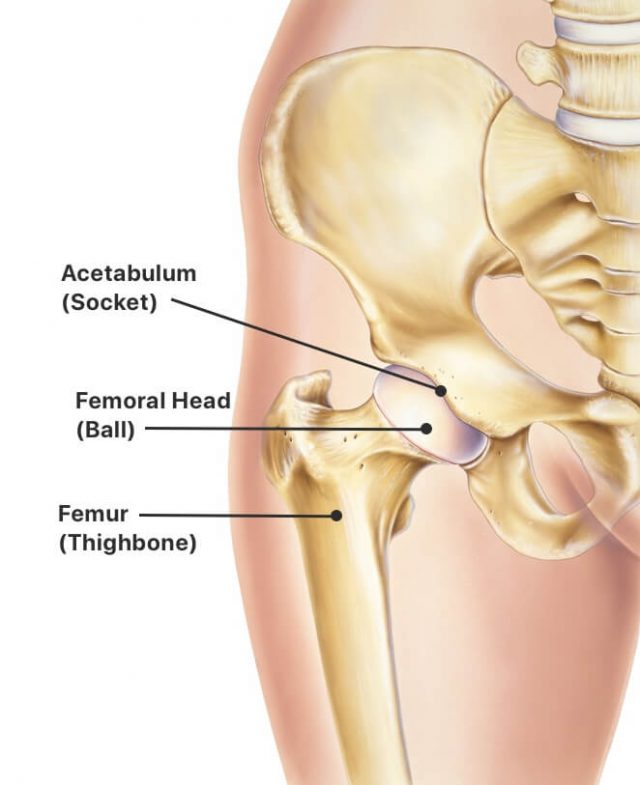
Expand
In a healthy hip, the head of the femur bone fits securely in the acetabulum, forming the hip articulation.
Hip replacements are one of the most common joint replacement operations in the The states, with more than than 300,000 performed in the state each year, according to the American Academy of Orthopaedic Surgeons. An estimated 2.5 meg Americans were living with artificial hips in 2010, according to a study published in 2022 in The Journal of Bone and Articulation Surgery.
Although hip replacement surgery is common, it is a major surgery that has a variety of risks. Complications during surgery or later in life can cause debilitating side effects. That'due south why doctors and patients should consider the benefits and risks of the operation.
Candidates for Hip Replacement
The most likely candidates for hip replacement include people who feel hurting that disrupts regular activities. In addition to people with osteoarthritis or hip injuries, people with rheumatoid arthritis, osteonecrosis or os tumors may need hip replacements to save pain. People also receive hip replacements to increase mobility and meliorate overall quality of life.
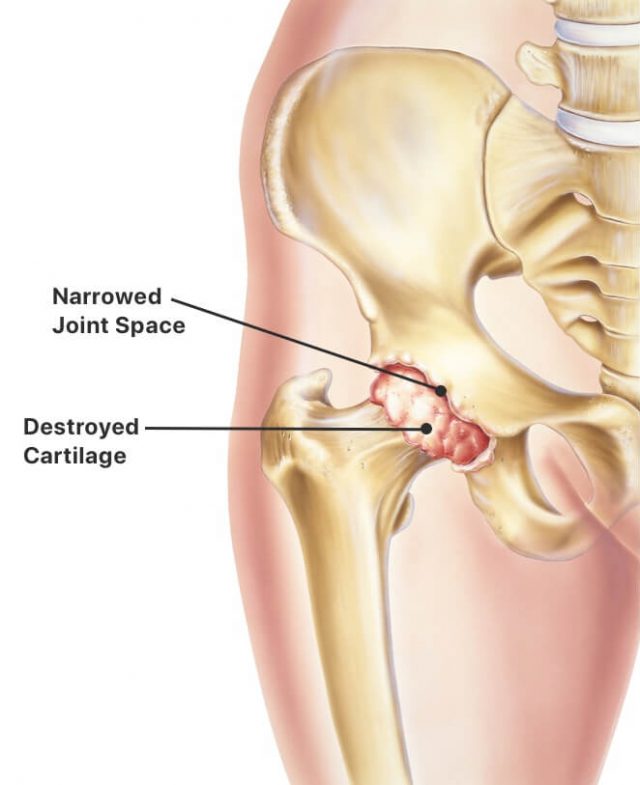
EXPAND
Damage to the hip articulation from osteoarthritis is the most mutual reason for hip replacement surgery.
Signs that You lot May Need a Hip Replacement
- Hip pain that prevents walking, bending, climbing stairs or doing daily chores
- Hurting in your hip even when not walking or standing
- Stiffness in your hip that prevents lifting your leg
- Failure of non-surgical treatments to provide relief
- Depression or other changes in your mental health
- Your doctor rules out other health issues
Doctors will also consider the risk for each individual patient. Age, weight and medical conditions such as diabetes can affect a patient'southward take chances for complications following hip replacement, co-ordinate to Dr. H. John Cooper, a board-certified orthopedic surgeon.
The risk of getting a specific complexity "tin can be somewhere between 0 and 3 percentage for somebody who'south healthy and in good shape," Cooper told Drugwatch. "There are risk factors that are greater than 20 per centum in patients with the incorrect sort of combination of hazard factors."
People ages 50 to eighty have historically been the most mutual candidates for hip replacements. However, young teenagers with juvenile arthritis and people over the age of 80 have successfully undergone hip replacements.
Many people experience pain relief and improvements in daily living later on receiving a hip replacement, only the devices are not miracle cures. Hip replacement surgery has a number of risks, and the implants wear out over time. To avert complications, people who receive implants should non jog, run or participate in loftier-impact sports. They may be able to swim, bike or perform other low-bear on activities.
Alternatives to Hip Replacement
Most doctors will ask patients to consider alternative methods for relieving hurting or increasing mobility before recommending an bogus hip implant.
I such option called subchondroplasty attempts to promote natural bone growth to repair damaged hips. Doctors inject a bone substitute into the hip joint. The material fills gaps, voids and lesions in the os. Over fourth dimension, the body begins replacing the material with natural bone, which can sometimes lead to permanent repairs.
Alternative treatments usually tried before hip replacement include:
- Exercises that increase muscle around the hip
- Canes, walkers and other walking aids
- Over-the-counter medication for pain without inflammation
- Nonsteroidal anti-inflammatory drugs for pain with inflammation
- Osteotomy of the femur, a procedure that involves cutting and realigning the bone
But when alternative treatments do not provide relief, increase mobility or improve quality of life, doctors may consider a hip replacement procedure. They will analyze the patient's medical history, take 10-rays and perform concrete exams to test hip mobility and strength. They may also conduct MRIs or CT scans.
Types of Hip Replacement Surgery
Surgeons perform hip replacements by using a posterior arroyo or an inductive approach. With a posterior hip replacement, the incision is made at the side or back of the hip. During inductive hip replacement, the surgeon makes the incision at the front end of the hip.
The posterior approach is more than common in part considering it allows ameliorate visibility of the hip joint, though the inductive arroyo is condign more prevalent. There is no significant deviation betwixt the procedures every bit far equally recovery from surgery, but the anterior procedure may pose a higher hazard of nervus damage that could crusade numbness in the outer thigh.
Patients who are younger than fifty, have a normal body mass index or who are in overall good wellness may be candidates for minimally-invasive surgery. During this surgery, the incision is smaller and recovery fourth dimension after the surgery is shorter.
Special os cement is normally used to concord hip implants in place, but some surgeons utilize a cementless fixation technique. Devices that do non crave cement accept a textured surface that allows the bone to grow onto the implant and secure it. A hybrid total hip replacement involves implanting the loving cup without cement and setting the ball in place with cement.
Total Hip Replacement
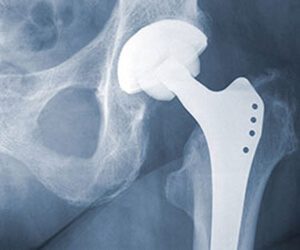
Total hip replacement is the nearly mutual hip surgery. It uses artificial components to supplant the entire hip structure. During the procedure, surgeons insert a stem into the patient'south femur, or thighbone, for stability. They replace the head of the femur with a ball and replace the natural socket in the hip joint with an artificial cup.
Partial Hip Replacement
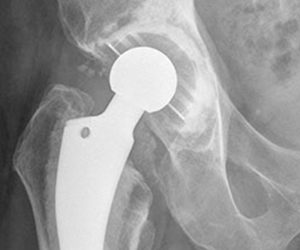
Fractional hip replacement removes and replaces the patient'due south femoral head, which is the ball at the top of the femur, or thighbone. It does not replace the socket. A ceramic or metallic brawl is attached to the top of a stem that'southward inserted into the hollow centre of the femur. Surgeons typically perform this surgery to repair certain types of hip fractures.
Hip Resurfacing
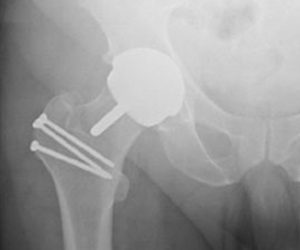
Hip resurfacing helps relieve pain from cartilage loss. A surgeon trims damage from the natural bone ball at the summit of the thighbone. He or she so resurfaces it with a smooth metallic covering. The surgeon too lines the natural bone socket of the hip with a metal lining or shell.
Bilateral Hip Replacement vs. Staged Hip Replacements
If both hips require replacement, surgeons may choose a staged hip replacement. They replace one hip at a time, letting the patient recover from the beginning surgery earlier doing the second one. Alternatively, the patient may undergo a bilateral hip replacement in which both hips are replaced at the same fourth dimension.
A bilateral hip replacement tin can mean a unmarried trip to the operating room and the potential for less overall recovery time. But information technology doesn't piece of work for all patients.
The risk of blood loss during surgery is greater with bilateral hip replacement and patients are under anesthesia for twice as long — upward to four hours. Patients are besides more likely to require longer hospitalization or inpatient rehab.
Bilateral replacements ordinarily involve younger, healthy and active patients who can handle more rigorous physical therapy and practice following hip replacements.
Types of Implants
Device manufacturers design hip implants to mimic the natural motility of the trunk. The principal differences between implants are their size and the textile of the components.
Hip implant components are made of polyethylene (plastic), metallic, ceramic or a combination of the materials.
Metallic-on-Polyethylene (MoP)
1 of the nearly common types of hip implant, metal-on-polyethylene has been used since the 1960s. The ball is made of metal and the socket has a plastic lining or is made entirely of polyethylene. Plastic has a smooth surface that causes little friction while the ball moves inside the socket. However, MoP implants tin produce plastic droppings, which tin can eventually crusade the implant to fail. Wear debris from the breakdown of materials could pb to a condition called osteolysis, which occurs when inflammation destroys the bone and the implant in the os loosens.
Metal-on-Metal (MoM)
Metal-on-metal hip devices are no longer available in the United States, though thousands of people may have been implanted with them. Around the turn of the century, many new hip implants were made from metallic-on-metal components, significant the ball, stem and socket were all made out of metal. Manufacturers believed the metals were more durable than other materials. All the same, MoM hip implants can shed metal particles that may cause a number of serious wellness issues, including a type of metal poisoning called metallosis. Several models of metal-on-metallic hips were recalled or taken off the market.
Attorney Holly Ennis reveals whether doctors are yet using metal-on-metallic hip implants.
Ceramic-on-Polyethylene (CoP)
Ceramic-on-polyethylene devices couple a ceramic brawl with a socket made from plastic. They may also substitute the plastic socket for a polyethylene lining in the natural socket. With plastic parts, in that location is even so a gamble of vesture that causes debris that leads to osteolysis.
Ceramic-on-Ceramic (CoC)
Ceramic-on-ceramic devices combine a ceramic head with a ceramic lining in the hip socket. A 20-year follow upwardly study plant that overall survivorship of CoC implants was 88 percent. It increased to 91 percent when researchers looked simply at failures related to materials, according to Dr. Laurent Sedel, who presented the study at the SICOT XXV Triennial Globe Congress 2011. The most common failures were loosening of the lining and component fractures.
Ceramic-on-Metallic (CoM)
The U.Southward. Food and Drug Assistants approved the outset ceramic-on-metallic hip device in 2011, making the blueprint relatively new. The ball is made of ceramic and the socket has a metal lining.
Hip Replacement Risks and Complications
Nearly people who take hip replacement surgery do not experience major complications. Dislocation and loosening are the nearly common complications of hip replacement, according to the National Institute of Arthritis and Musculoskeletal and Skin Disease.
Problems after hip surgery can include:
- Dislocation
- Loosening of implant
- Infection
- Claret clots
- Os growth beyond normal edges of the bone
Source: National Found of Arthritis and Musculoskeletal and Peel Disease
Some complications occur at much college rates with specific implant designs, said Cooper, who is an banana professor of orthopedic surgery at Columbia University Medical Center. He categorizes device-specific concerns into two major groups.
The starting time involves certain implants with metal-on-metallic bearings that are associated with a higher chance for failure and metal release from the bearing'south surface. The other major class of concern involves metallic-on-polyethylene bearings that release metallic debris where the pieces of the stem or head come up together.
"The reactions are like: inflammation around the joints, fluid collections, and in more advanced cases, tissues damage, os loss or some of the more rare simply serious complications like claret vessel constriction or compressions," Cooper said.
A couple of the devices accept been recalled and are no longer unremarkably used in the United States or across the world. But there are nevertheless plenty of patients in the U.s. who have these devices within of them, Cooper said. Some patients in the United States are walking effectually with implants that were not available in the U.s.a. but were available in Europe or in other countries, and they are having the same kinds of bug.
Well-nigh hip implants concluding for ten years to 15 years, only the devices wear out more quickly if the patient has an active lifestyle. Some implants wear out faster than others, requiring revision surgery to remove, repair or replace the device. An estimated 10.4 percent of hip replacements require revision surgery, according to a 2022 study published in Arthroplasty Today.
Lawsuit Data
Revision surgery is one of the injuries named in hip replacement lawsuits. Learn more.
View Lawsuits
Hip Implant Recalls
A hip replacement call back usually happens when the implant causes complications in large number of people implanted with the device. Several leading device makers have issued large recalls related to hip complications.
Johnson & Johnson subsidiary DePuy Orthopaedics issued a global recall for the visitor'due south ASR and ASR 40 Acetabular Cups in 2010. The reason given was the company'south "ongoing mail-market surveillance," pregnant the visitor was reviewing reported problems. DePuy never recalled its metal-on-metallic versions of its Elevation hip but quietly pulled them off the market. People have filed more than than 20,000 lawsuits over DePuy'southward ASR and Pinnacle metal-on-metal hips.
Stryker recalled 9,003 ABG II Modular hip stems in April 2012 after reports of fretting and corrosion. These devices were not metal-on-metallic ball and socket components. The problem came from the connections in the stem that held the implant to the femur. The Stryker devices came with different sized and angled necks that allowed surgeons to customize fit for patients. The junction where these connected shed particles into patients' tissue.
U.k.-based Smith & Nephew recalled all 6,266 lots of its Modular Redapt Hip Systems in 2022 due to "a higher than anticipated complaint and adverse consequence trend." Just a year earlier, the visitor had recalled almost 6,000 Birmingham Hip Resurfacing, or BHR, components due to "revision rates which were higher than established benchmarks."
Zimmer recalled 19,000 Durom cup components in 2008 considering of fake and misleading labeling. And Wright Medical recalled shells for its Conserve and Dynasty hip replacement lines in 2022 due to metal droppings causing the need for revision surgeries in patients with the devices.
The FDA classifies metal-on-metallic hip systems as Class III, higher take a chance medical devices, but many of them were cleared for sale in the U.s.a. through the agency'southward 510(yard) premarket notification process. Under the process, companies demand merely to testify that their products are "substantially equivalent" to other devices already approved past the FDA before they tin can outset selling their products.
"Metal-on-metal implants were usually used upward to a tertiary of the time in hip replacement in the early on and mid-2000s," Cooper said.
The devices had higher than expected failure rates. Problems led companies to call back some models. Others were simply pulled off the marketplace.
Today, there are no FDA-approved metal-on-metal hip implants available in the United States. There are only two FDA-approved metal-on-metal resurfacing systems available. And any company that wants to sell metal-on-metal hips can no longer rely on the 510(thousand) procedure. Companies have to provide scientific evidence that their devices are rubber and effective.
"The patients with these more problematic or riskier implants demand regular follow-up with an orthopedic surgeon familiar with hip or knee replacements."
Studies and information from national registries showed metal wear debris from metal-on-metallic hip implants can crusade inflammation around the joints and local tissue damage with what doctors phone call adverse local tissue reactions, or ALTR.
"Oftentimes in these patients when these kinds of reactions develop, if caught early on, the begetting surface tin can be changed so permanent harm is not typically washed," Cooper said.

Dr. H. John Cooper, assistant professor of orthopedic surgery, Columbia University Medical Centre.
Merely if the problem goes unaddressed for a period of time, and then patients tin suffer irreversible, permanent tissue damage or os loss. In extreme cases, patients may feel nerve compression or compression of blood vessels. In very extreme cases, the metal being released from these articulation replacements can go to loftier systemic levels in the blood and can potentially cause concern about systemic side effects that affect the patients' heart, vision or hearing.
"The patients with these more problematic or riskier implants demand regular follow-up with an orthopedic surgeon familiar with hip or genu replacements," Cooper said. "If they oasis't been within the past year, I would recommend making an engagement with their surgeon who put the device in."
Many people with these problematic bogus hips take opted for revision surgery to receive a new hip implant. Some patients filed lawsuits against hip implant manufacturers, challenge the companies knew their hip systems were lacking.
Source: https://www.drugwatch.com/hip-replacement/
0 Response to "Can You Have an Mri With a Hip Replacement"
إرسال تعليق